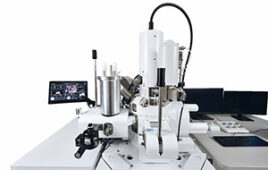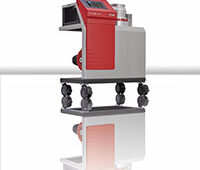A spectrometer is an instrument which identifies the underlying frequencies in a spectrum. This is a very broad technique that can be applied to different form of energy spectrum in order to measure different types of physical properties in matter. Most commonly, a spectrometer refers to an optical spectrometer.

Spectra and Resonance
Resonance, and how it relates to a spectrum, can be clearly understood with a simple example. Imagine you are pushing someone on a swing. If you push them once every five minutes, they won’t swing very high. They also won’t swing very well if you push them ten times every second. The only way to get them to swing high is to match the frequency of your pushing to the natural frequency that the swing wants to swing at. If we plot all the different frequencies that we could push the swing at, against the height, or amplitude, of the swing, we will see a spike at the natural frequency. When the excitation frequencymatches the natural frequency this is known as resonance. The range of all the different excitation frequencies is a spectrum. The spike at the resonant frequency is referred to as a spectral line.
Atoms, molecules and crystal structures all have resonant frequencies; in fact, they have a number of different one with different intensities. These are caused by effects such as coupling between quantum mechanical states. When matter is excited by an oscillating energy source, such as electromagnetic radiation, it will respond most strongly when the frequency of the energy matches one of its resonant frequencies. Observing the spectral lines for a material enables its composition to be determined.
Types of Spectrometer
Spectrometers can use electromagnetic radiation at many different frequencies including microwave, visible light and X-rays. They may also use particle beams, sound waves or vibrations within solid materials. The spectral lines observed may be absorption lines, indicating energy absorbed by the material, emission lines, or other effects such as scattering, reflection or impedance.
The most common type of spectrometer is an optical spectrometer. This is used to observe the light emitted by a sample, by diffraction. Early optical spectrometers used prisms but modern instruments normally used computer controlled diffraction gratings and movable slits. The sample of material may be heated to incandesce using electrical resistance or some other form of radiation. In astronomy, spectrometers are used to observe the spectral lines emitted by hot gases.
Spectrum analysis, which mathematically identifies spectral lines and their intensities, is often performed electronically. This typically uses a mathematical technique known as Fast Fourier Transform (FFT).
Another widely used form of spectroscopy is nuclear magnetic resonance (NMR) spectroscopy. These are typically large and expensive instruments in which a sample is placed within a strong magnetic field and excited with radio waves. The resulting nuclear magnetic resonance in atomic nuclei is observed with radio receivers. They provide a highly accurate way of characterizing small molecules.





Tell Us What You Think!